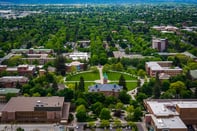Published on
The New Big Player: Workforce Education Heading Into Recession

With adult learners looking to upskill and reskill, workforce education will become critical in serving these learners as we head into a new normal. Learner demographics—and whole institutions—will be looking to these units to provide the right training fast and efficiently. With this responsibility, institutions need to be tuned into industry needs, and communication is the key to do this. In this interview, Anton Reece discusses how technical education is adapting to this new shift in learning and responsibility, what makes an effective recession response, and longitudinal trends that may emerge heading into a new normal.
The EvoLLLution (Evo): How is the shift to remote learning affecting students that are in technical or career-oriented programming?
Anton Reece (AR): As we speak, COVID-19 has certainly created a set of unique challenges. Our nursing clinicals, welding, HVAC programs that require hands-on assessments are all affected. This is the last week of courses, and finals are next week. Students are certainly questioning what will happen because they need those courses to finish up their semester.
Hopefully, by May 18th things will move into a phase one re-opening format. That will impact a small number of students whose labs and clinicals are the top priority. Could we provide a safe environment with social distancing rules in place so those students can succeed? That’s what we’re exploring, and there are no guarantees.
In order to bring even a small number of students back, you need PPEs and protective gear. We’ve donated all of the PPE we had, so it’s going to take some finessing. This crisis really impacted our thinking and capacity issues with everything being online. We are one of 16 colleges, and there are over 105,000 students whose education we are responsible for. There are a lot people doing everything online, but our top priority are students with labs or enrolled in technical programs.
Evo: In regard to communication, how important is the website in making sure that all the stakeholders involved with the college have an understanding of what’s going on during a fast-changing time?
AR: My first career was in broadcast news, so communication has always been critical for me. And it’s been very challenging. I create daily afternoon updates, and those updates link to our website and all of our social media platforms. I also shoot videos along the way geared towards specific populations; students, faculty and staff, and the community. We also do a lot of press releases.
The delivery of this format also provides its challenges. We’re communicating to a vast variety of learners: students who didn’t want to go online, ones in special programs, from low-income households, underserved populations, GED adult students online. There’s a lot of complexity in that. But this situation really heightened my awareness about technology moving forward as we serve a 13-county area. There are four rural counties and two southern counties that have limited, if any, broadband. Some of those students have to drive 52 miles to come work outside on campus because we can’t allow them in the buildings to get a Wi-Fi signal, which is very challenging.
Evo: How should community and technical colleges prepare to scale in order to serve students looking for upskilling and reskilling opportunities in the coming months?
AR: They should be doing it very carefully, very strategically and very patiently. Then do those three things all over again. I would say that this recession is different from 2008. In 2008, whole states weren’t shutting down. Many of our students work in retail and service industries, and in this situation, they can’t work any of the side jobs that they could’ve in the past. Typically, we know that when unemployment drops, enrollment skyrockets. But I think this will be a little different and that people will come out in a survival mode, focusing on paying bills and trying to keep food on the table while putting education second.
You have to hope for the best but prepare for the worst. Certainly, we stand ready as a community and technical college to provide the training if people need it. Obviously, there will still be some demand for certificates and short-term programs. We may get some rebound from traditional four-year institutions because of the medical resident license setting, parents who may be very cautious to send their kids off, plus the precarious economic factors facing the population. People’s pocketbooks have been hit pretty hard. But that could also give us a boost in the community college world.
Evo: Are short-term programs going to be more important to supporting the response to mass unemployment across the community than more traditional degree or academic programs?
AR: The short answer is yes. Even prior to COVID-19, there had been a growing core over the last three or four years about time to work. It plays to our advantage because certificates and associate programs are conducted in a shorter timeframe and geared towards directly transitioning into the workplace. This pandemic has really worsened prospects, when you start applying the socioeconomic strata and some of the cultural nuances. Everyone is going to be coming out of this scrambling, trying to earn their livelihood, and some will require a measure of training. So, we need to take that and prepare for any demand that comes our way.
Evo: Is there anything you’d like to add about the work that you and your team are doing to create an effective recession response?
AR: Higher education is uniquely positioned because the academy teaches us to pay attention to longitudinal trends. What starts off as an outlier could become some semblance of a norm. This could permanently alter the delivery process.
When it comes to engaging with students, there’ll be some added challenges, including working with and understanding new technology, engaging different populations in different settings, and with alternate modes of delivery. It has implications certainly for professional development training—associative technology and pedagogy will be big factors for about a quarter of our students who are fully online.
Students who tend to perform the worst tend to also be in lower socioeconomic groups. And we’ve had strong conversations about whether or not it’s the mode of delivery that’s the issue. Or is it that we are approaching every student with a common philosophy: engaging populations without customizing, adapting, modifying or adjusting?
The third area that will have a large impact on us is supply/demand and the expectations of business and industry. There will be even more demand for an accelerated timeframe to get people ready for work quickly. Workforce training and solutions are going to be big players moving forward. It’s going to be about the speed at which we can get people trained to work.
This interview was edited for length and clarity.
Editor’s note: This interview was recorded on April 29, 2020.
Author Perspective: Administrator
Author Perspective: Community College



